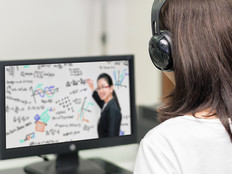Telepresence Robots Give Distance Students Their Own Seat at the Table
Distance learning, or distance education, where students take online courses or attend classes virtually, is on the rise. More than one in four students (28 percent) now take at least one distance education course, according to a recent study conducted and co-sponsored by the Online Learning Consortium.
Remote learning affords opportunities but also presents challenges, including the loss of camaraderie and associated enhanced learning opportunities. At Michigan State University, telepresence robots have helped shift that dynamic in profound and promising ways.
As the head of Michigan State University’s Design Studio and a professor in the doctoral program for educational psychology and educational technology students, I’ve helped implement the shift from onsite only to a hybrid program where students can attend the same classes in person and remotely.
The Importance of Presence
Interactive videoconferencing, which enables offsite students to join a class that meets in a physical classroom, has significant limitations. Often students who join via videoconferencing sense that they are easily forgotten by those who are physically present. They also sometimes feel the need to apologize when they want to contribute to what is happening in the physical space. Finally, they miss out on the informal conversations that happen before class starts or that take place as students and the instructor walk to the door.
Enter robotic telepresence, which allows remote students to truly have a seat at the table, both physically and metaphorically speaking.
For the last two years, we’ve experimented with various types of robotic telepresence technology in the classroom. The technology has demonstrated its power to enhance remote learners’ educational experience in very important ways.
For example, one of our students commented that it was only when she started to attend class via robot that it began to matter if she knew the names of other students who were physically present in class.
When we asked her why she felt that way, she noted that it was finally possible for her to have one-to-one interactions with her onsite classmates, and that made the experience for her much more personal.
The Challenges of Selecting a Telepresence Robot
Not all robots are created equal. The current options in the marketplace have various benefits and challenges, which we found by experimenting with several different styles and brands over time.
Pragmatic considerations include price per device, battery life, required network throughput and complexity of use. Important aspects of embodiment include freedom of movement, audio, and video quality and support for various strategies for engagement. Confidence of use is also important across the board.
On the more modestly priced end of the scale, we first tried the Kubi, which is a mounted tablet on a “neck” that sits on a table, desk or other surface. It rotates, tilts and turns while the remote user engages in conversation.
It’s easy to use but it can’t move itself to a different location. While remote users won’t have to worry about steering the unit around the room, they will need to coordinate with someone onsite to physically move the robot from place to place. We are still learning what effects this partnership has on the remote student who needs assistance and the local student who provides the assistance.
We also tried two devices that can physically transport themselves — Double and Beam. Both of these devices stand approximately five feet tall and have a Segway-type bottom with a video monitor mounted on top.
While they are significantly more costly, the big plus is they offer distance learners the ability to truly be mobile, physical presences at school.
Ultimately, Beam has been the best fit for our program. It has built-in, clear video and audio, plus it offers a more natural experience and a greater social presence. However, it requires more bandwidth than the devices from Double or Kubi.
When asked about the experience of having a robot counterpart on campus, one of our remote students, Chris Fahnoe from Illinois, said, “It lends a lot more authenticity and makes me feel more connected in terms of participation, conversation, and having more control over movement and space.”
Addressing the Logistical Challenges of Telepresence
One of the most important areas for improvement revealed in our research is to help the “pilot” perceive his or her own projection through these devices. For example, when a student joins a class via robot, it is very difficult to manage the audio level so that she or he is loud enough for people to hear, yet not so loud that the student is shouting over others in the classroom.
This becomes a bigger problem when the class switches between whole group and small group interactions, since audio levels must be adjusted repeatedly.
Common features in videoconferencing tools, like chat and screen sharing, are not available or as useful with robotic telepresence devices. We needed to combine multiple tools to achieve the same functionality.
Ultimately, we found that robotic telepresence can be a game-changer when it comes to enhancing and improving academic experiences for distance learners.
No single solution is always best, so we continue to explore and experiment with a variety of options in order to figure out what option is preferable in a particular environment for a particular goal. My colleagues and I are excited to continue exploring telepresence technology as capabilities evolve and expand.









